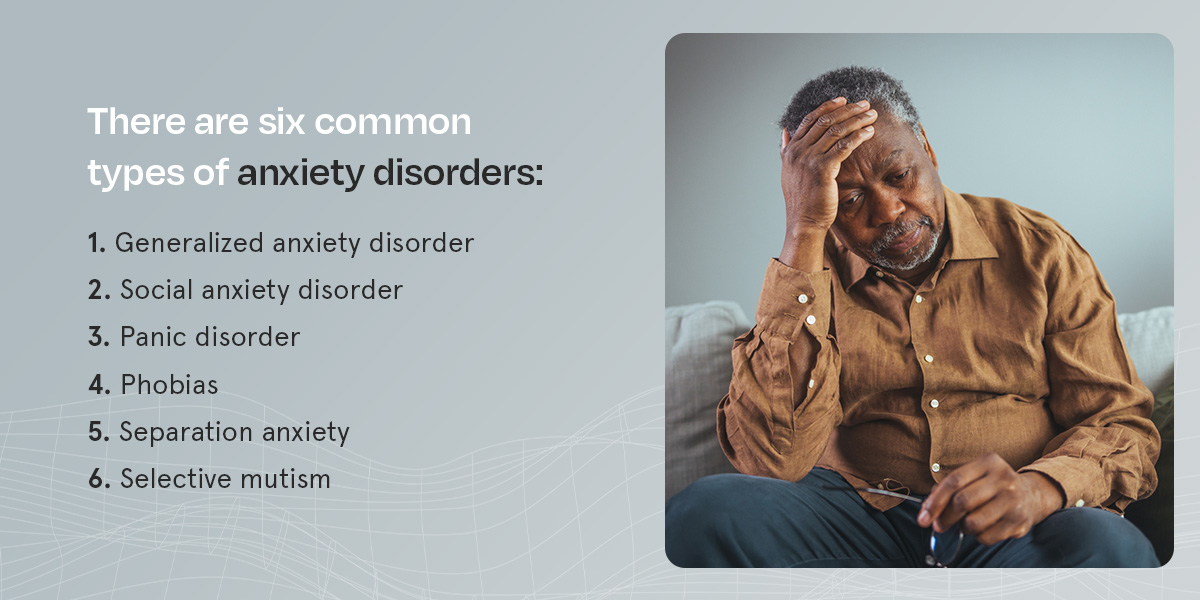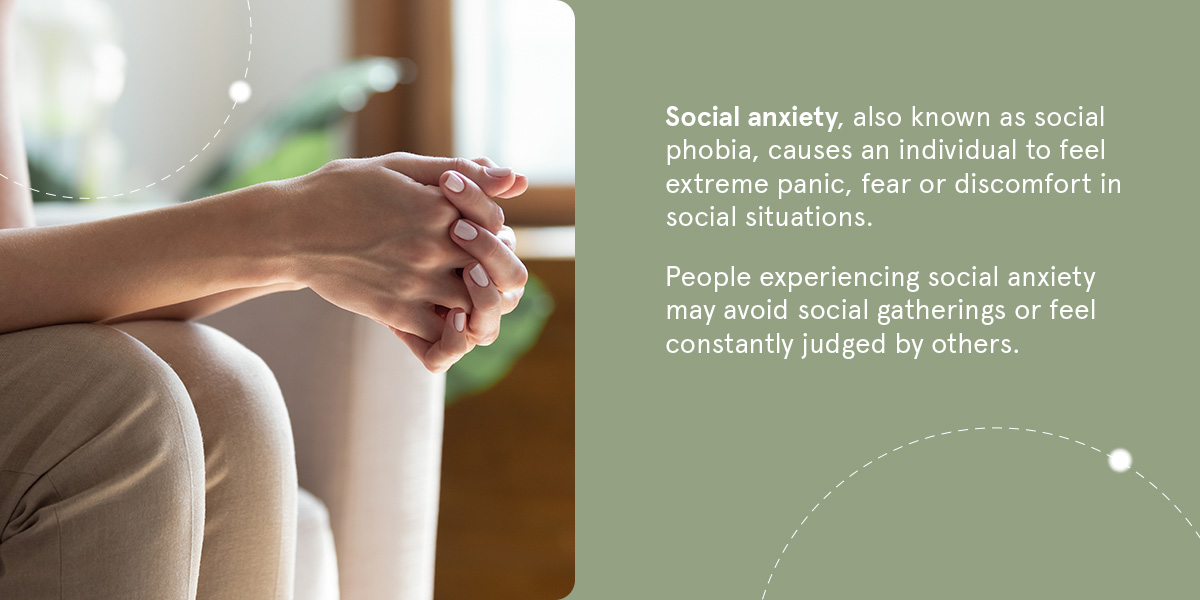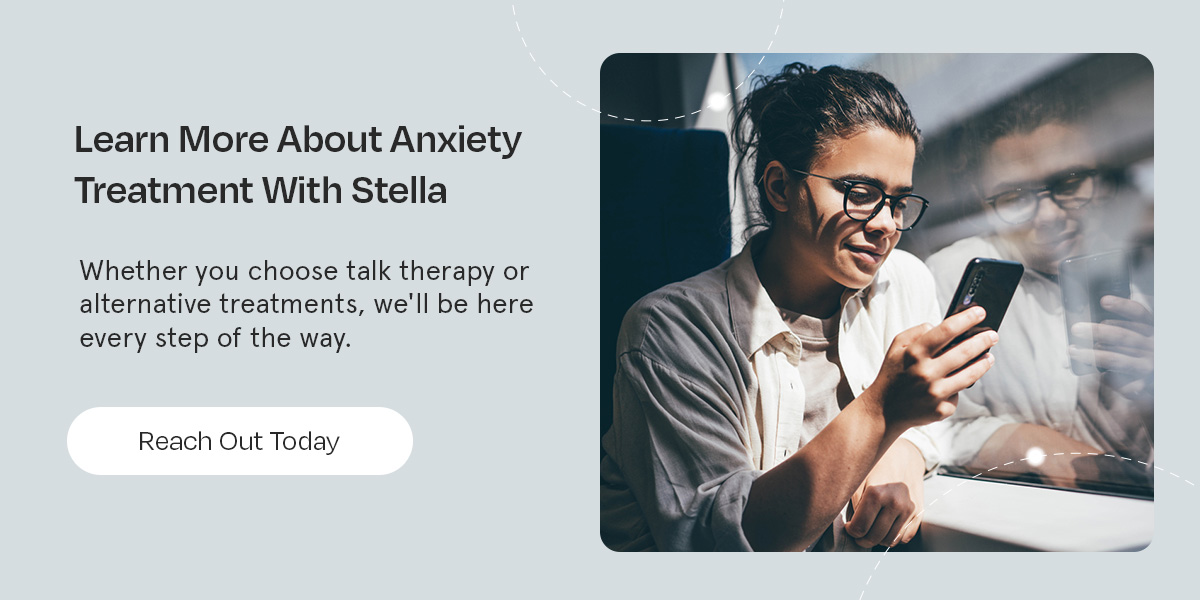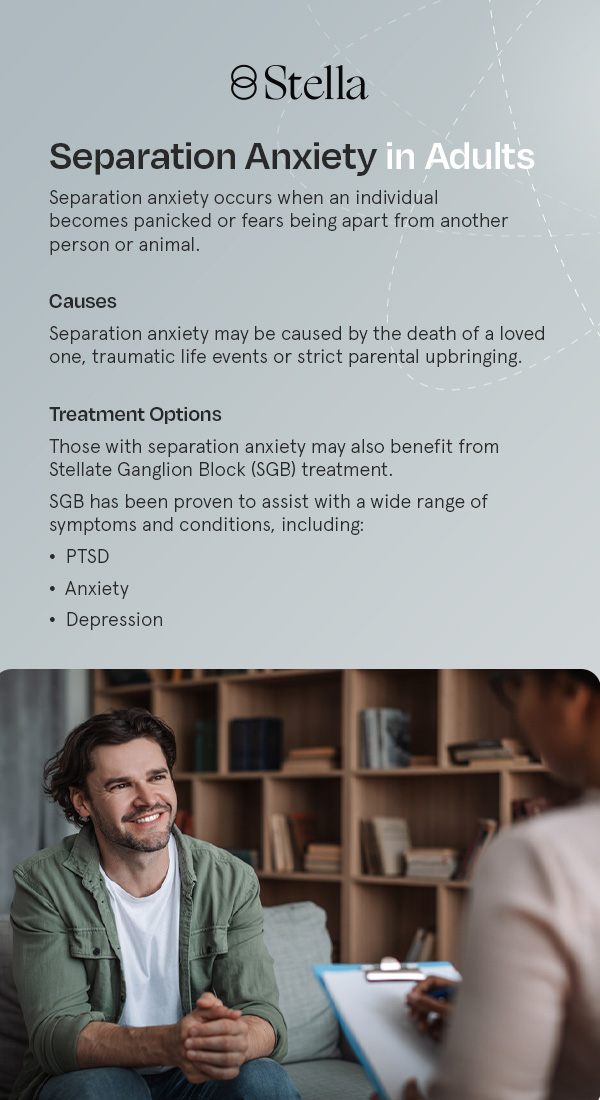The Different Types of Anxiety Explained

Nearly 1 in 3 people are affected by anxiety, yet there is still much to be learned and understood about anxiety and how it affects us. At Stella, we're grounded in science and rooted in compassion. We know how important it is to provide clinically led, individualized care for mental health challenges, and it's our mission to help individuals get relief from anxiety and trauma-induced symptoms. By understanding the signs and symptoms of anxiety conditions, you can sooner find a multi-modality care approach that works for you.
Understanding Anxiety
Anxiety is normal and can occur in various situations, such as when public speaking or in an unfamiliar circumstance. However, when anxiety becomes excessive or intense or starts to impact daily life, the individual may be experiencing an anxiety condition. Anxiety is a persistent feeling of dread, fear or worry during everyday situations.
This level of anxiety is often overwhelming and may prevent the individual from being able to perform daily activities, such as going to work or interacting with others. Anxiety conditions can also be difficult to control, leading many to avoid situations that may worsen anxiety.
There are several different types of anxiety conditions, and their symptoms manifest differently in every person. One person may feel restless with racing thoughts, while another may experience sweating palms or dizziness. It's also possible for individuals to have more than one anxiety condition.
What Are the 6 Major Types of Anxiety Disorders?
Anxiety can become a long-term condition and, when left unaddressed, can take over an individual's life and prevent them from participating in beloved activities. Anxiety can also inhibit a person's ability to fully engage in relationships, friendships, careers, education and responsibilities. There are six common types of anxiety conditions:

- Generalized anxiety disorder
- Social anxiety disorder
- Panic disorder
- Phobias
- Separation anxiety in adults
- Selective mutism
Understanding Generalized Anxiety Disorder
Generalized anxiety disorder (GAD) refers to severe, ongoing anxiety that affects most parts of a person's life. GAD makes people feel extremely nervous, worried or fearful about many situations. Usually, the anxiety worsens when an individual is not able to control or plan situations out of fear that bad things will happen. People with generalized anxiety commonly have vague or nonspecific symptoms that can cause them to feel overwhelmed constantly.
Though officially labeled a disorder in the Diagnostic and Statistical Manual of Mental Disorders (DSM-5), Stella prefers to label it as a condition — a challenge you can overcome.
The common thread is that people with this condition often worry excessively about things — sometimes for months at a time — even if there is little to no reason to stress. It's common for people with GAD to fear the worst outcome in situations, and the individual may be unable to stop the anxiety. This type of dread usually ends up interfering with how the person functions in life.
Symptoms
GAD symptoms in children and adults can vary from mild to severe, depending on their environment, genetic makeup and many other factors. Some of the many symptoms of GAD include:
- Irritability
- Tension
- Exhaustion
- Restlessness
- Constant anxiety
- Difficulty concentrating
- Being easily fatigued
- Nausea
- Headaches
- Distress in everyday situations, such as in school or at work
- Trouble falling asleep or staying asleep
- Difficulty breathing
- Being easily startled or unable to relax
- Urinating often
- Tearfulness
- Difficulty making decisions
Causes
While the Anxiety and Depression Association of America reports that GAD is twice as common in women than men, various combinations of factors play a role. Traumatic or stressful events, genetics and chemical imbalances in the brain and body could all contribute. Studies show that women are also more likely to seek therapeutic help for various conditions due to societal norms around how men are expected to behave, emote and function.
Individuals can also inherit GAD from one of their parents. Additionally, certain personality styles may be more prone to anxiety and GAD.
Treatment Options
GAD treatment can include psychotherapy, antidepressant medication, anti-anxiety medication, Dual Sympathetic Reset (DSR), an advanced Stellate Ganglion Block (SGB) Treatment. Ketamine may also be potentially effective in treating treatment-resistant generalized anxiety conditions.
Outside of medication management and therapies, it is also important to be able to build your sense of safety when managing your anxiety conditions. One way to do this is through the use of coping skills. It is important to practice them day by day, as your brain, when in crisis, will not want to try something it is not used to. Try to integrate the following skills in tandem with other daily life tasks to help rewrite neural pathways to be able to build that sense of felt safety.
- Relaxation techniques
- Physical exercise
- Stress management
- Mindfulness techniques
- Grounding techniques
- Meditation
If an individual has any sort of trauma condition that can trigger dissociation, these coping strategies may not work right away and could be more distressing. A professional can help develop a plan that incorporates your specific needs.
Social Anxiety: Causes, Symptoms and Treatment

Social anxiety, also known as social phobia, causes an individual to feel extreme panic, fear or discomfort in social situations. This could include meeting new people, asking for help in a public place, dating, making phone calls or speaking to people at work or school. People experiencing social anxiety may avoid social gatherings or feel constantly judged by others. These individuals often have overpowering symptoms combined with an excessive internalized fear of their own self-worth or self-doubt. For example, someone might be anxious about appearing awkward or unintelligent, which further fuels their anxiety.
Symptoms
Here are the main symptoms of social anxiety:
- Sweating
- Blushing
- Increased heart rate
- Panic attacks
- A feeling of intense fear or dread around other people
- Feeling extremely self-conscious
- Feeling nervous to the point of nausea
- An intense fear of being judged by others
- Sensitivity to criticism
- Having difficulty speaking
- Avoiding social situations that could trigger anxiety
- Fear of seeming anxious in front of others
- Not knowing what to say to other people
Individuals who recognize the unwarranted fear may still be unable to control the physical and emotional symptoms.
Causes
Social anxiety conditions can be inherited or caused by an overactive amygdala — the part of the brain that processes fear and anxiety. Social anxiety can also be learned, such as a child modeling anxious behavior from a socially anxious parent.
Treatment Options
Cognitive behavioral therapy (CBT) is a common psychological treatment method for social anxiety. Medications like selective serotonin reuptake inhibitors (SSRIs) are used to manage social anxiety, and beta-blockers or dual sympathetic resets may also help prevent physical symptoms.
Trauma-informed talk therapy may also improve treatment outcomes for those with social anxiety. Stella partners with All Points North (APN) to offer a trauma-informed talk therapy curriculum that helps those with various anxiety-related conditions heal from trauma and find relief from symptoms.
The combination of psychotherapy and pharmacotherapy, which generally includes therapy and medication management, can significantly improve the quality of life for people with social anxiety conditions. A multi-modality care approach of Stella's biological treatments and talk therapy support can result in long-term positive outcomes.
Unveiling the Mystery: GAD vs. Panic Disorder
Many people with anxiety may be familiar with feelings of panic or panic attacks — intense levels of anxiety that result in severe physical reactions. Panic attacks can be extremely stressful and frightening for the individual and may even cause a person to confuse the panic for a heart attack or other physical emergency. Social anxiety can also cause panic attacks.
While some people experience panic attacks a handful of times throughout their lives, individuals with panic attacks suffer from frequent, unexpected panic attacks, sometimes lasting long periods or occurring multiple times a day. This severity can be incredibly debilitating and exhausting for the individual. Panic attacks can significantly affect a person's ability to participate in common activities out of fear something will trigger a panic attack, even if there is no discernable reason to be panicked.
Despite what some may think, panic attacks and GAD are not the same. Panic disorder criteria involve recurring, panicked bodily reactions, while GAD involves persistent worry.
Symptoms and Triggers
The following are common symptoms of panic disorder:
- Trembling
- Rapid heart rate
- Sweating or chills
- Heavy breathing
- Weakness
- Tingly, numb or shaking hands
- Feeling out of control
- Feeling a sense of impending doom
- A sudden overwhelming feeling of fear or anxiety
Common triggers for panic attacks include:
- Caffeine
- Social events
- Financial, relationship or general stress
- A traumatic event or reminders of past traumatic experiences
- Conflicts with others
- Being out in public near large groups of people
- Lack of sleep
Causes
There is no one cause for panic attacks. It may be inherited through genes or occur as a result of trauma. Some experts believe panic attacks are the body's way of setting off a false alarm caused by an overactive survival instinct. Some experts believe that panic attacks are caused by an overactive amygdala — your brain's emotional processing nerves. This sets off a physiological reaction that triggers your body's survival instincts to kick on, resulting in a panic attack or the symptoms of your panic condition.
Treatment Options: How Do I Stop My Panic Disorder?
Panic attacks can be managed through CBT and medication.
Panic attacks caused by anxiety may also be relieved through science-based alternative treatments. Ketamine infusion therapy, for example, can help alleviate comorbid anxiety symptoms, treatment-resistant generalized anxiety and social anxiety disorders. Stella offers Ketamine infusion therapy and Ketamine integration sessions to unlock long-lasting change and relief.
Dual Sympathetic Reset (DSR) has also been shown to reduce some types of anxiety by as much as 50%. Dual Sympathetic Reset is an advanced Stellate Ganglion Block (SGB) treatment that specifically works to alleviate anxiety and panic attacks by helping reset an overactive sympathetic nervous system to its baseline. This can help reduce nervousness or jumpiness in individuals with panic disorder while improving sleep and concentration.
Phobias: Understanding Your Fears
Individuals with a phobia experience anticipatory anxiety surrounding a situation, activity, animal or object. A phobia is characterized as an excessive, persistent or unrealistic fear. An individual who feels such intense fear surrounding a specific object or situation may experience a panic attack or go to great lengths to avoid it.
Types of Phobias and Symptoms
The following are common types of phobias:
- Heights
- Animal attacks, such as dog bites
- Spiders
- Tight or closed-in spaces
- Tunnels
- Flying
- Germs
- Driving
- Dentists
- Vomiting
- Blood/injection/injury
Symptoms of phobias are very similar to panic attacks, which include:
- Shaking or trembling
- Sweating
- Rapid heartbeat
- Upset stomach or nausea
- Dizziness
- Lightheadedness
- Shortness of breath
- A sensation of uncontrollable fear or anxiety
- A feeling that the object of the phobia must be avoided at any cost
- Being unable to function when exposed to the phobia
Causes
Phobias often result from an unpleasant first encounter with the feared thing. For example, a child who accidentally falls into a pool may develop a phobia of water in adulthood. However, phobias can also be a learned response that develops in children.
Agoraphobia and How It Relates to Anxiety
Agoraphobia is a phobia strongly associated with anxiety. It refers to the intense stress or anxiety an individual feels when leaving an environment deemed safe. Usually, people with agoraphobia avoid crowded public places like malls, concerts, shopping centers and airports. Some may even refuse to leave home if it is the only place they feel safe.
Agoraphobia is rooted in the fear of feeling anxiety or panic, often combined with a fear of being embarrassed or losing control. While similar to social anxiety, agoraphobia is different. Agoraphobia is the fear of people outside of an individual's safe space, while social anxiety is the fear of interactions with people.
How Is Agoraphobia Diagnosed and Treated?
Within the DSM-5, agoraphobia can be diagnosed by experiences of extreme fear outside of their home and has severe, persistent symptoms. Individuals can overcome agoraphobia with behavioral therapy, CBT, biological treatment, medication, meditation or a combination of these methods.
The goal of specific phobia treatment is often to help the individual learn to understand and react differently to their fears and help control negative thoughts. Treatment may also include regular exercise, eating a well-balanced diet and practicing breathing exercises.
Separation Anxiety in Adults: An Overlooked Issue
Separation anxiety occurs when an individual becomes panicked or fears being apart from another person or animal. While this is a common issue with children, who tend to fear being separated from their parents, adults can also develop this condition due to various factors. Because of how overwhelming anxiety can feel, it is common for someone to be on edge when separated from a person or animal they consider safe.
Symptoms
In adults, separation anxiety tends to manifest in high levels of anxiety or panic attacks when a loved one is not in reach. Other symptoms and warning signs of separation anxiety include:
- Following loved ones around
- Fear of being abducted
- Fear of being left alone
- Fear that something bad will happen to themselves or a family member if separated
- Avoiding activities or situations where an individual will be separated from their loved one
- Social withdrawal
- Difficulty concentrating
- Trouble breathing
- Diarrhea
- Dizziness
- Headaches
- Extreme worry
Causes
Separation anxiety may be caused by the death of a loved one, traumatic life events or strict parental upbringing. Those who already have an anxiety diagnosis may have a higher risk of developing separation anxiety.
Treatment Options
Some individuals may try to fight separation anxiety by practicing separation or distracting themselves. Family and group therapy can also be helpful, as well as SSRIs and other types of medications.
Those with separation anxiety may also benefit from DSR Stellate Ganglion Block (SGB) treatment. DSR SGB has been proven to assist with a wide range of symptoms and conditions, including PTSD, anxiety and depression. Stella's advanced SGB protocol may help regulate the fight-or-flight response and relieve symptoms of trauma that individuals with separation anxiety experience.
What Is Selective Mutism?
Selective mutism is a type of anxiety condition where a child or adult cannot speak in certain social settings but is not entirely mute. In situations where the person feels comfortable, such as at home, they may speak perfectly fine.
Symptoms
The primary symptom of selective mutism in adults is a persistent failure to speak in social settings for an extended period of time. Other symptoms include:
- Social withdrawal
- Feeling nervous or uneasy in social situations
- Appearing socially awkward
- Appearing rude or disinterested
- Acting stubborn or aggressive
- Being excessively shy or anxious
- Talking at all other times other than in a specific place or situation
- Difficulty interacting with others in the workplace
Causes
Though selective mutism is more common in children, adults can also develop this condition. Contrary to common belief, selective mutism is not caused by autism or the individual not understanding the spoken language. Selective mutism in teenagers and adults is often caused by:
- Traumatic experiences
- Untreated psychological conditions
- Sound-processing issues
- Low self-esteem
Some individuals may develop selective mutism as a result of a speech or language challenge, such as stuttering, which may cause embarrassment about how they speak in front of others.
Having social anxiety or separation anxiety can also trigger selective mutism. This can make it difficult for individuals to engage socially later in life. However, selective mutism can go away with treatment.
How to Manage Selective Mutism in Children and Adults
Selective mutism treatment depends on the individual's unique needs. In some cases, medication may help. People with selective mutism may also respond well to stimulus fading, which involves gradually introducing the individual to less comfortable speaking situations.
Shaping is another type of treatment that focuses on encouraging the individual to communicate with audible speech. Some treatment options for selective mutism in children include speech therapy or family therapy.
Learn More About Anxiety Treatment With Stella
Dealing with anxiety day in and day out can be exhausting, and it can prevent you from doing the things you love. If you are struggling with anxiety, know that there are innovative treatment options available to provide impactful relief.
At Stella, our goal is to administer effective treatment to individuals suffering from anxiety, depression and post-traumatic stress disorder (PTSD) which Stella refers to as post-traumatic stress injury (PTSI). We know there's no one-size-fits-all solution to your anxiety, which is why we offer several treatments aimed at your individual needs. Whether you choose talk therapy or alternative treatments, we'll be here every step of the way to help you regain control of your mental well-being. To learn more about relieving your anxiety symptoms with Stella, reach out to us today.

